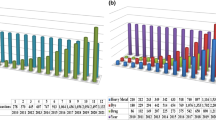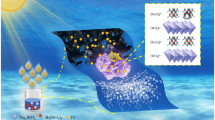Abstract
In this work, the influence of the preparation method of ZSM-5/TiO2 hybrids on the photocatalytic performance for removal of formaldehyde (HCHO) or trichloroethylene (C2HCl3) in gas phase was analyzed. For this purpose, two methods for the synthesis of the hybrids, the incipient wetness impregnation (I) and the mechanical mixing method (M), were selected. The photocatalysts were characterized by N2 adsorption–desorption, TEM, UV–Vis spectroscopy, XRD and electrophoretic migration. Also, the adsorption ability of the individual materials and hybrids was analyzed. ZSM-5/TiO2 hybrids showed higher photocatalytic activity than bare TiO2, independently of the preparation method selected. Mechanical mixing is a simple and easily scalable method to prepare highly active photocatalyst with high amounts of titania. The internal diffusion processes of the reactants to the active sites could be improved due to the micro–mesoporous structure developed on these hybrids. Incipient wetness impregnation method leads to photocatalysts with higher photodegradation rates per active site. The hybrids synthetized by this method show TiO2 nanoparticles homogeneously dispersed on the ZSM-5 phase. The fraction of TiO2 exposed on the surface ca. 75 mol% was similar for materials prepared by both methods, explaining the similar adsorption and photocatalytic properties, independently of the TiO2 content. The nature of the pollutant has an important role in the adsorption and photocatalytic properties of the composites. Finally, the effect of the incorporation of the zeolite in the photocatalytic system was analyzed. For this purpose, the influence of the zeolite and titania arrangement in the sample holder on the photodegradation rate was analyzed. Although the incorporation of the zeolite induces a positive effect on the photocatalytic performance, independently of the position on the sample holder, a clear synergistic effect when both phases were in intimate contact such as in the ZSM-5/TiO2 hybrid was observed.









Similar content being viewed by others
References
Allport DC, Gilbert DS, Outterside SM (2003) MDI and TDI: safety, health and the environment: a source book and practical guide. John Wiley & Sons, Chichester
Mo J, Zhang Y, Xu Q, Lamson JJ, Zhao R (2009) Photocatalytic purification of volatile organic compounds in indoor air: a literature review. Atmos Environ 43(14):2229–2246
Ohno T, Sarukawa K, Tokieda K, Matsumura M (2001) Morphology of a TiO2 photocatalyst (Degussa, P-25) consisting of anatase and rutile crystalline phases. J Catal 203(1):82–86
Hernandez-Alonso MD, Fresno F, Suarez S, Coronado JM (2009) Development of alternative photocatalysts to TiO2: challenges and opportunities. Energy Environ Sci 2(12):1231–1257
Fresno F, Portela R, Suarez S, Coronado JM (2014) Photocatalytic materials: recent achievements and near future trends. J Mater Chem A 2:2863–2884
Suárez S, Coronado JM, Portela R, Martín JC, Yates M, Ávila P, Sánchez B (2008) On the preparation of TiO2-sepiolite hybrid materials for the photocatalytic degradation of TCE: influence of TiO2 distribution in the mineralization. Environ Sci Technol 42(16):5892–5896
Yoneyama H, Torimoto T (2000) Titanium dioxide/adsorbent hybrid photocatalysis for photodestruction of organic substances of dilute concentrations. Catal Today 58:133–140
Corma A, Garcia H (2004) Zeolite-based photocatalysts. Chem Commun 13:1443–1459
Kuwahara Y, Aoyama J, Miyakubo K, Eguchi T, Kamegawa T, Mori K, Yamashita H (2012) TiO2 photocatalyst for degradation of organic compounds in water and air supported on highly hydrophobic FAU zeolite: structural, sorptive, and photocatalytic studies. J Catal 285(1):223–234
Shams-Ghahfarokhi Z, Nezamzadeh-Ejhieh A (2015) As-synthesized ZSM-5 zeolite as a suitable support for increasing the photoactivity of semiconductors in a typical photodegradation process. Mater Sci Semicond Process 39:265–275
Jansson I, Suárez S, García-García FJ, Sánchez B (2015) Zeolite–TiO2 hybrid composites for pollutant degradation in gas phase. Appl Catal B 178:100–107
Klimenkov M, Nepijko SA, Matz W, Bao X (2001) The study of Ti doped ZSM-5 particles and cavities inside them. J Cryst Growth 231(4):577–588
Portela R, Jansson I, Suárez S, Villarroel M, Sánchez B, Ávila P (2017) Natural silicate-TiO2 hybrids for photocatalytic oxidation of formaldehyde in gas phase. Chem Eng J 310:560–570
Durgakumari V, Subrahmanyam M, Subba Rao KV, Ratnamala A, Noorjahan M, Tanaka K (2002) An easy and efficient use of TiO2 supported HZSM-5 and TiO2 + HZSM-5 zeolite combinate in the photodegradation of aqueous phenol and p-chlorophenol. Appl Catal A 234(1–2):155–165
Takeuchi M, Deguchi J, Hidaka M, Sakai S, Woo K, Choi P-P, Park J-K, Anpo M (2009) Enhancement of the photocatalytic reactivity of TiO2 nano-particles by a simple mechanical blending with hydrophobic mordenite (MOR) zeolite. Appl Catal B 89(3–4):406–410
Minero C, Catozzo F, Pelizzetti E (1992) Role of adsorption in photocatalyzed reactions of organic molecules in aqueous titania suspensions. Langmuir 8(2):481–486
Haick H, Paz Y (2001) Remote photocatalytic activity as probed by measuring the degradation of self-assembled monolayers anchored near microdomains of titanium dioxide. J Phys Chem B 105(15):3045–3051
Barrett EP, Joyner LG, Halenda PP (1951) The determination of pore volume and area distributions in porous substances. I. Computations from nitrogen isotherms. J Am Chem Soc 73(1):373–380
Saito A, Foley HC (1991) Curvature and parametric sensitivity in models for adsorption in micropores. AIChE J 37(3):429–436
Patterson AL (1939) The Scherrer formula for X-ray particle size determination. Phys Rev 56(10):978–982
Kubelka P (1931) Ein beitrag zur optik der farban striche. Z Tech Phys 12:593–603
Smoluchowski Mv (1906) Zur kinetischen theorie der brownschen molekularbewegung und der suspensionen. Ann Phys 326(14):756–780
Gil-Llambias FJ, Escudey-Castro AM (1982) Use of zero point charge measurements in determining the apparent surface coverage of molybdena in MoO3/γ-Al2O3 catalysts. J Chem Soc Chem Commun 9:478–479
Driessen MD, Miller TM, Grassian VH (1998) Photocatalytic oxidation of trichloroethylene on zinc oxide: Characterization of surface-bound and gas-phase products and intermediates with FT-IR spectroscopy. J Mol Catal A 131(1–3):149–156
Suárez S, Arconada N, Castro Y, Coronado JM, Portela R, Durán A, Sánchez B (2011) Photocatalytic degradation of TCE in dry and wet air conditions with TiO2 porous thin films. Appl Catal B 108–109:14–21
Weitkamp J (2000) Zeolites and catalysis. Solid State Ionics 131(1–2):175–188
Miranda-García N, Suárez S, Sánchez B, Coronado JM, Malato S, Maldonado MI (2011) Photocatalytic degradation of emerging contaminants in municipal wastewater treatment plant effluents using immobilized TiO2 in a solar pilot plant. Appl Catal B 103(3–4):294–301
Carrott PJM, Sing KSW (1986) Characterization of Silicalite-1 and ZSM-5 zeolites by low-temperature nitrogen adsorption. Chem Ind 17:786–787
Rouquerol J, Rouquerol F, Sing KSW (1998) Adsorption by powders and porous solids: principles, methodology and applications. Elsevier Science, London
Tao Y, Kanoh H, Abrams L, Kaneko K (2006) Mesopore-modified zeolites: preparation, characterization, and applications. Chem Rev 106(3):896–910
Bayram H, Onal M, Yılmaz H, Sarıkaya Y (2010) Thermal analysis of a white calcium bentonite. J Therm Anal Calorim 101:873–879
Jansson I, Kobayashi K, Hori H, Sánchez B, Ohtani B, Suárez S (2017) Decahedral anatase titania particles immobilized on zeolitic materials for photocatalytic degradation of VOC. Catal Today 287:22–29
Zhang Q, Li R, Li Z, Li A, Wang S, Liang Z, Liao S, Li C (2016) The dependence of photocatalytic activity on the selective and nonselective deposition of noble metal cocatalysts on the facets of rutile TiO2. J Catal 337:36–44
Zhang H, Banfield JF (2000) Understanding polymorphic phase transformation behavior during growth of nanocrystalline aggregates: insights from TiO2. J Phys Chem B 104(15):3481–3487
Fu X, Zeltner WA, Anderson MA (1995) The gas-phase photocatalytic mineralization of benzene on porous titania-based catalysts. Appl Catal B 6:209–224
Ballmoos RE, Higgins JB (1990) Collection of simulated XDR powder patterns from zeolites. IZA, Amsterdam
Xu Y, Langford CH (1997) Photoactivity of titanium dioxide supported on MCM41, zeolite X, and zeolite Y. J Phys Chem B 101(16):3115–3121
Kavan L, Grätzel M, Gilbert SE, Klemenz C, Scheel HJ (1996) Electrochemical and photoelectrochemical investigation of single-crystal anatase. J Am Chem Soc 118(28):6716–6723
Anderson C, Bard AJ (1997) Improved photocatalytic activity and characterization of mixed TiO2/SiO2 and TiO2/Al2O3 materials. J Phys Chem B 101:2611–2616
Reyes-Coronado D, Rodríguez-Gattorno G, Espinosa-Pesqueira ME, Cab C, Coss Rd, Oskam G (2008) Phase-pure TiO2 nanoparticles: anatase, brookite and rutile. Nanotechnology 19(14):145605
Hernández-Alonso MD, Tejedor-Tejedor I, Coronado JM, Soria J, Anderson MA (2006) Sol-gel preparation of TiO2-ZrO2 thin films supported on glass rings: influence of phase composition on photocatalytic activity. Thin Solid Films 502(1–2):125–131
Zheng S, Gao L, Zhang Q-H, Guo J-K (2000) Synthesis, characterization and photocatalytic properties of titania-modified mesoporous silicate MCM-41. J Mater Chem 10(3):723–727
Tawari A, Einicke W-D, Gläser R (2016) Photocatalytic oxidation of NO over composites of titanium dioxide and zeolite ZSM-5. Catalysts 6(2):31
Gao X, Wachs IE (1999) Titania–silica as catalysts: molecular structural characteristics and physico-chemical properties. Catal Today 51(2):233–254
Suttiponparnit K, Jiang J, Sahu M, Suvachittanont S, Charinpanitkul T, Biswas P (2010) Role of surface area, primary particle size, and crystal phase on titanium dioxide nanoparticle dispersion properties. Nanoscale Res Lett 6(1):1–8
Esmaili-Hafshejani J, Nezamzadeh-Ejhieh A (2016) Increased photocatalytic activity of Zn(II)/Cu(II) oxides and sulfides by coupling and supporting them onto clinoptilolite nanoparticles in the degradation of benzophenone aqueous solution. J Hazard Mater 316:194–203
Derikvandi H, Nezamzadeh-Ejhieh A (2017) Synergistic effect of p–n heterojunction, supporting and zeolite nanoparticles in enhanced photocatalytic activity of NiO and SnO2. J Colloid Interface Sci 490:314–327
Nussbaum M, Paz Y (2012) Ultra-thin SiO2 layers on TiO2: improved photocatalysis by enhancing products’ desorption. Phys Chem Chem Phys 14(10):3392–3399
Paz Y (2010) Composite titanium dioxide photocatalysts and the “Adsorb & Shuttle” approach: a review. Solid State Phenom 162:135–162
Xu Y, Langford CH (1995) Enhanced Photoactivity of a titanium(IV) oxide supported on ZSM5 and zeolite A at low coverage. J Phys Chem 99(29):11501–11507
Acknowledgements
The studies presented in this paper were supported by the Spanish Ministry of Economy and Competitiveness (projects CTM-2011-25093, LIFE12-ENV_ES_000280 and Mss. Jansson’s Ph.D. Grant BES-2012-055758). The authors want to thank the Research Support Unit from ICP-CSIC for XRD and BET analysis. Authors are grateful to Dr. Yates for his valuable support on the interpretation of the N2 adsorption–desorption results.
Author information
Authors and Affiliations
Corresponding author
Rights and permissions
About this article
Cite this article
Jansson, I., Suárez, S., García-García, F.J. et al. ZSM-5/TiO2 Hybrid Photocatalysts: Influence of the Preparation Method and Synergistic Effect. Top Catal 60, 1171–1182 (2017). https://doi.org/10.1007/s11244-017-0805-1
Published:
Issue Date:
DOI: https://doi.org/10.1007/s11244-017-0805-1




